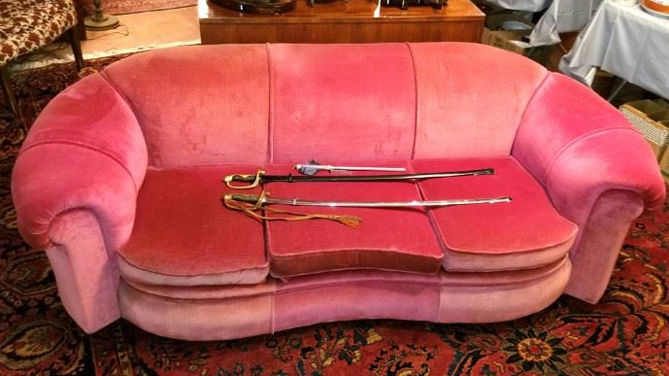
At the risk of becoming a de-cluttering blog, I’ve got to point out that there’s a place for de-cluttering in the garden. I know, because I’m the gardening equivalent of a hoarder.
I cling to plants that need to head to the compost pile. I interfere with Kelly’s much more advanced pruning skills. I resist the periodic and necessary need to swap plants out. Gardens are, by definition, a mediation on impermanence. As Hereclitus says, “Everything changes and nothing remains still . . . you cannot step twice into the same stream.” Heed Hereclitus’ enigmatic saying and you’ve got the essence of gardening and nature: periods of equilibrium punctuated by change, sometimes fast, sometimes slow. De-cluttering our tended gardens is to work in imitation of and in concert with nature.
So what would be some de-culuttering steps in the garden that welcome and work with change?
- First would be getting rid of junk such as construction debris and those failed projects Kelly alluded to in her last post. We’re pretty good about this, but the backyard has accumulated a few items that need to go.
- Replacing under-performing plants. Particularly in small spaces like ours there is no room for plants that are sickly or just don’t look attractive. Ditto for fruit trees that have never produced. I’m with Piet Ouldolf on this: if possible, plants in our tended spaces need to look good year round (even when dormant) and they need to provide wildlife habitat.
- Rethinking the garden. Even the best gardener has to rethink and renew a garden periodically. Many perennials become gangly, trees shade out other plants and things just generally change. Sometimes you have to mimic nature’s floods and fires and make a radical shift.
- Weeding and thinning. We got behind on this and we’re paying the price. This is a matter of poor scheduling, subject matter for an upcoming series of posts (if I can ever schedule time to write those scheduling posts). Let’s just say there was some cursing while pulling out a robust and thorny Opuntia yesterday that would have been much easier to remove two years ago.
- Pruning. This is a source of considerable marital discord. Kelly is much better at it than I am, and yet I end up micromanaging and mansplaining. The fact is that many fruit trees, particularly peaches, need to be hacked back dramatically when dormant. With the exception of avocados, everything else needs to be kept small for ease of harvest and to fit more trees in a small space.
What gardening de-cluttering steps did I leave out? When do you more northerly gardeners do your garden de-cluttering?
And a note on the photo which shows Kelly pruning our pomegranate tree. To her right is a cardoon and, at the bottom of the slope is a huge prickly pear cactus. Something all these plants have in common? Wicked thorns. This makes deferred de-cluttering even more curse-worthy.
Addendum
Mrs. Homegrown chimes in:
Erik spoke of some topics of marital discord in the garden, and yet none of those hold a candle to our perpetual debate about installing some kind of garden shed or storage system in our back yard. It’s shocking, really, that we don’t have such a thing, but he is very resistant to the idea, for reasons of time, effort, money and aesthetics.
All good objections! But honestly, how can one post about clutter in the garden and point to the poor plants when the real problem with clutter in our garden comes in the form of empty pots, bags of soil and amendments with no home, gloves housing spiders, tools leaning here, there and everywhere, never where you need them. Our climate alone allows us to (mostly) get away with this behavior. Elsewhere it would all rust or rot if left out like this.
I know it’s not the KonMari way to add storage space or devices to deal with clutter, but this is more like having a car with no garage, and then wondering why the driveway is always crowded.
So…um…if any artisanal shack manufacturer would like to send us a small shed for review, we’re open to proposals!






Not so much *de* cluttering as prevention, but something Kelly talked about in the DIYers decluttering post about not buying things for a project unless that project is basically in progress/first in the queue etc. For gardening, this means not buying amazing plants/seedlings/seeds before I’m absolutely positively ready to prioritize them as a PROJECT to plant, deadline/action date included. Too many wee green things around here have been left to die in their transport pots before I got to putting them in the dirt because I put the plant before the project.
DH has a serious problem with plant *removal*, as he doesn’t like the bare stage before a new plant has taken hold/gotten to the size of what got removed. (Which, in part, is where I’ve already bought the replacement plant, but he’s not ready to part with the old one yet 😉 )
I have found that living in the frozen North works like a charm, because it forces me to put away everything I took out before the first snowfall of winter. That’s the time I pull up dead plants, put away all the garden tchochkes, the hose and watering can, the plant supports and all the other detritus that we accumulate over the summer. Absolutely anything left out becomes a tripping hazard when it’s covered with snow; in addition, it will freeze solidly to the ground and be immovable until late April.
This is not to say that we don’t have glitches: last spring I found the kitchen shears lying in a garden bed when the snow finally receded – thank heavens they were stainless – and a few weeks later, a pair of my missing eyeglasses reappeared where the tomatoes had grown.
I always have grand plans for plants and seeds. But, as my problems worsen, few plans ever see the light of day. Plants sit and die.So, I vowed this year not to make plans that most likely never come to fruition.
There are several dozen pots sitting around with dead plants mostly. The two fig trees died. However, I have plans for all the dirt. I must cover the trench for the water line. THAT is where the dirt will go…one potful at a time. Then, I can stack the pots neatly in the basement.
Two days ago, I noticed there were too many things/pots cluttering up the place. Oh, these things have been here for months.
I love to lop things, but I have trusted exbf for the last time. He has no idea what to do. He thinks pruning is making a plant shorter and squarer.
This year is totally dedicated to food plants except for one flower for my hanging basket. Since I can barely do anything at all now, I am trying to spend about ten minutes each day to clean up the dead and dying mistakes.
Since it was only 35 degrees F today, I suspended de-cluttering after one pot.
I think it is better to de-clutter in the winter before plants, good or evil, obscure the yard or garden spaces. I can see things as they push through the ground and more easily make good decisions.
I try to prune in March, and rip out any larger shrubs or cut down trees in Fall. Too risky in spring, as I find birds nesting even in small shrubs. I will get out and remove the remnants of annuals when we get a nice day in March.
The construction of the storage building might actually help eliminate some of the clutter, if, as was the case with us, much of that clutter consisted of salvaged building materials scattered in piles all around the property. Of course, this statement skirts that fact that the old barn wood, the ginormous 2x4s from the roofing pallets and our neighbor’s old redwood fence panels were in this scattered state for literally years before we finally built that oh-so-cool, old-looking artisanal tool shed and chicken coop.
Like Kelly talked about in that earlier post, the allure of being “green,” saving still-useful old materials from the landfill, and creating treasure from other people’s trash sure leads to a heck of a lot of crap lying around. My justification is, of course, that there those materials were when we finally found time and motivation for our projects, saving us lots of money and getting us some charmingly rustic outbuildings. And finishing them did feel great. But was it worth it to not use half the patio for 3 years? To have to park around the roofing crates for months? To stack and restack piles of old boards over and over again to get them out of the way for yet a different project? My inner hoarder responds with a resounding YES! but her opinions are decidedly suspect.
Reading about your decluttering efforts has generated many discussions with friends and much self-reflection for me. Enough to make me vow to try to start applying the “idea > commitment > deadline > materials” timeline you suggest. I’m hoping that will be easier since we recently used up many of those materials. I often go from idea straight to materials, or even begin with the materials, which then spark the idea. And there I stop. Enthralled by the “myth of potential” of my gathered materials, but not necessarily making those projects happen. And the barn wood sits. And sits. And eventually rots. But not enough to make me get rid of it because, of course, someday I’m going to actually build that (fill in the blank). Ah well… it’s a process, eh?
KonMari is actually speaking at Bookshop Santa Cruz this very evening. I am tempted to go. Even though she scares me…
About 99% of my outdoor clutter is things saved for projects. I probably will not add to the clutter and hopefully will be cleaned up by doing what I planned to do with the saved items.
I have basement with only an outdoor entrance where I did bring saved projects. However, I can not go down the concrete steps, so projects remain outdoors, something I need to fix by getting someone to move things down the stairs. I have the perfect solution to yard clutter but cannot utilize it very often.
In regards to your debate about a garden shed, I think that a small shed is a necessity for garden stuff. Why? Because as hard as I try to assemble all of my materials and tools beforehand for a given job, I inevitably forget something. Without a shed, I’d have to store the stuff somewhere in the house and, as conscientious as I am about removing dirty shoes before going in and out, it becomes tiring after the third or fourth time so I’m tempted to run in and out with my garden shoes on ‘just this one time’, dragging dirt/manure/compost in with me.
To avoid Too-Big Shed Syndrome, John built me a small cabinet-type thing which is about 4′ wide, 3′ high and about 2′ deep with two doors and a slanted roof on top to shed snow. It’s just big enough to store bags of soil amendments, potting soil and whatever, plus small tools, without allowing enough room to do any serious junk collection.
Kelly, you need a she-shaque. The thing with de-cluttering is that its about economics. I horde when broke-i could use this because it looks so useful!- and then spend all my in-clover hours throwing things away. I am abit weary of the decluttering movement because it is being touted by magazines that want to sell things. How to avoid the bioeconomic imperative to not collect? How to not be incredibly grumpy while de-cluttering? Is getting rid of stuff more important than happiness? I actually have nightmares about organizing stuff- its really hellish. I decluttered my art studio and now it seems bleak and forbidding. Sometimes clutter is alot more fun than stark japanese minimalism.